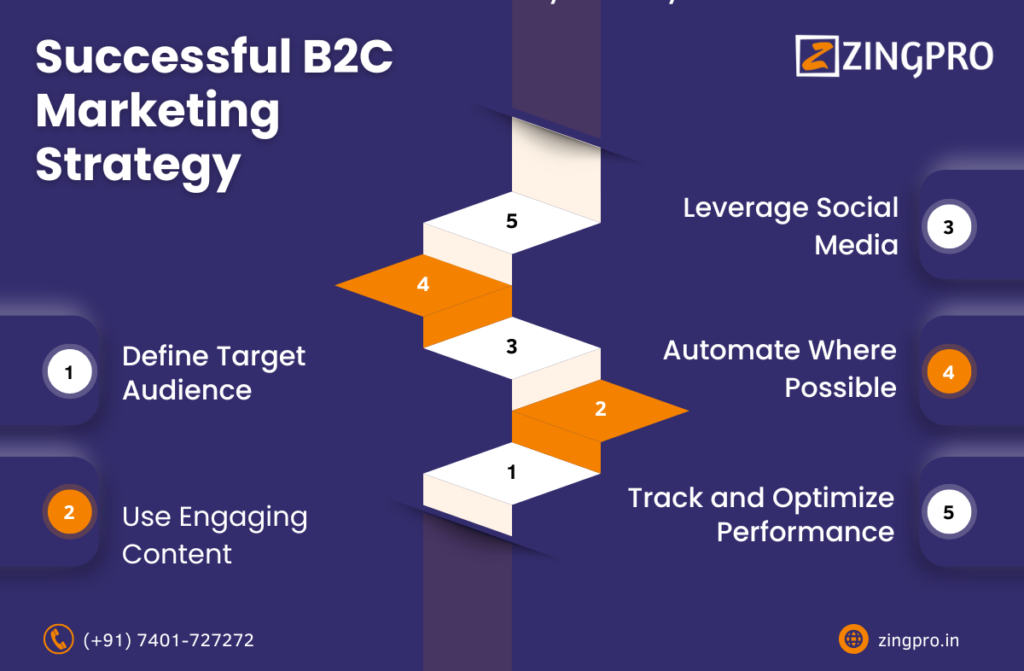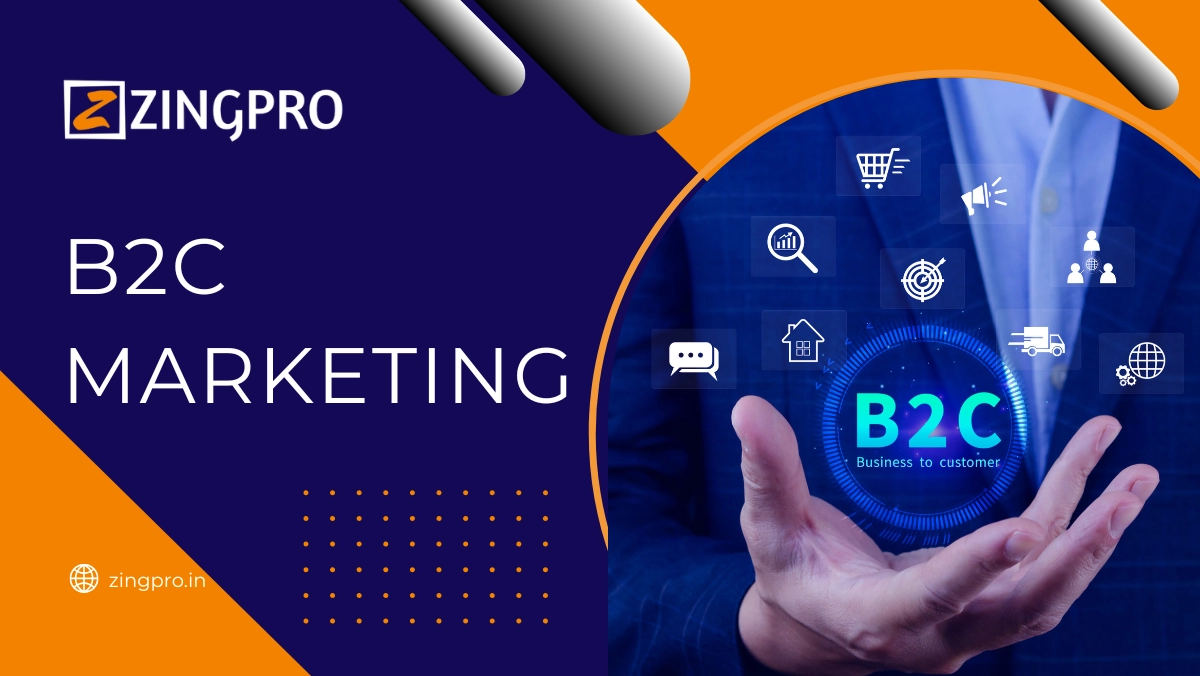B2C marketing (business-to-consumer) refers to the tactics and strategies businesses use to promote products directly to consumers. Whether you’re selling physical products, digital services, or subscriptions, a solid B2C marketing approach helps you engage customers, build brand loyalty, and drive sales. From social media campaigns to personalized email marketing, the right strategies can make a significant impact on your success. This guide covers essential B2C marketing strategies, tools, and trends that can help your business thrive.

B2C Marketing
In today’s competitive marketplace, B2C marketing is essential for businesses aiming to connect directly with consumers. Unlike B2B (business-to-business) marketing, where companies target other businesses, B2C marketing focuses on the individual consumer. Whether you’re selling clothing, tech gadgets, or online services, reaching your audience with the right message is crucial for success.
In this blog, we will explore what B2C marketing is, key strategies, tools, and future trends that can help your business engage customers and grow.
What is B2C Marketing?
B2C marketing, or business-to-consumer marketing, is the process of promoting products and services directly to individuals. The goal is to drive awareness, generate interest, and ultimately encourage consumers to make a purchase. It’s a customer-c`entric approach, focusing on building emotional connections with consumers through personalized messaging, offers, and experiences.
Key elements of B2C marketing:
- Customer Engagement: Connecting with customers through storytelling, social media, and personalized content.
- Consumer Behavior: Understanding how your audience shops, what they value, and how to meet their needs.
- Digital Channels: Leveraging platforms like social media, email marketing, and online ads to reach consumers directly.
B2C Marketing Strategies: Driving Consumer Action
An effective B2C marketing strategy involves understanding your customers and delivering personalized experiences that resonate with them. Here are some popular B2C marketing strategies:
- Content Marketing: Create engaging blog posts, videos, and social media content that educates and entertains your audience.
- Influencer Marketing: Collaborate with influencers who align with your brand and have a strong following to promote your products.
- Social Media Advertising: Use Facebook, Instagram, and TikTok ads to target consumers based on demographics, interests, and behaviors.
- Personalized Email Campaigns: Segment your email list to send relevant messages and offers based on consumer preferences.
- SEO: Optimize your website content to appear in search results when consumers look for products or services like yours.
These B2C marketing strategies can help you build brand awareness, increase engagement, and drive more sales.
The Difference Between B2C vs. B2B Marketing
Although B2C marketing and B2B marketing share some common goals, they are quite different in approach. B2B marketing targets other businesses, focusing on logic, product features, and ROI, while B2C marketing focuses on consumers’ emotions, desires, and personal benefits.
Key Differences:
- Decision-Making: B2B decisions often involve multiple stakeholders, while B2C purchases are usually made by individuals.
- Sales Cycle: B2B sales cycles are longer, whereas B2C transactions tend to happen quickly.
- Messaging: B2B marketing relies on data and product details, while B2C marketing focuses on creating an emotional connection with the consumer.
Understanding these differences helps businesses tailor their B2C marketing efforts to meet consumer needs effectively.
LinkedIn B2C Marketing: Using LinkedIn for Consumer Engagement
LinkedIn is often thought of as a B2B platform, but LinkedIn B2C marketing can be incredibly effective if used correctly. Here’s how B2C businesses can leverage LinkedIn:
- Content Sharing: Share high-quality content like articles, blog posts, or updates that showcase your brand’s expertise or values.
- Engaging Groups: Join and participate in relevant LinkedIn groups where your potential customers may be active.
- Thought Leadership: Build your brand’s presence by sharing industry insights, trends, and expert opinions.
While LinkedIn is not typically a primary channel for B2C marketing, it can be useful for certain industries, such as professional services, education, or luxury goods.
B2C Marketing Tools: Empower Your Strategy
To succeed in B2C marketing, you need the right tools to reach your audience, track results, and optimize performance. Here are some must-have tools:
- Mailchimp: Perfect for creating and automating email marketing campaigns.
- Hootsuite: A social media management tool that helps schedule and monitor posts across multiple platforms.
- Google Analytics: A powerful tool for tracking website performance, user behavior, and conversion rates.
- HubSpot: A marketing platform that includes CRM, email marketing, and analytics features.
- Canva: A simple design tool to create eye-catching visuals for social media, emails, and website content.
These B2C marketing tools help streamline your marketing efforts and enhance customer engagement.
B2C Marketing Automation: Streamlining Consumer Engagement
Automation is a game-changer in B2C marketing. It helps businesses reach the right customers at the right time without manual intervention. Here are ways to leverage B2C marketing automation:
- Welcome Emails: Automatically send a welcome series to new subscribers or customers.
- Abandoned Cart Emails: Remind customers who left items in their cart to complete their purchase.
- Loyalty Programs: Automate reward emails for frequent customers, encouraging repeat purchases.
With B2C marketing automation, businesses can maintain a personalized connection with consumers while scaling their marketing efforts.
Biggest Challenges of B2C Marketing
Despite its many advantages, B2C marketing comes with its challenges. Some of the biggest hurdles include:
- Consumer Attention: Capturing and holding consumers’ attention in a crowded digital landscape.
- Personalization: Creating personalized experiences at scale without losing efficiency.
- Data Privacy: Navigating consumer data privacy regulations like GDPR while offering personalized marketing.
Addressing these challenges requires a strategic approach and the right tools to balance personalization, automation, and compliance.
Designing an Effective B2C Marketing Strategy
Creating a successful B2C marketing strategy involves several key steps:
- Define Your Audience: Develop detailed buyer personas based on demographics, interests, and behaviors.
- Choose Your Channels: Focus on the platforms where your audience spends the most time—social media, email, or even YouTube.
- Set Clear Goals: Whether it’s brand awareness, lead generation, or sales, your strategy should have measurable objectives.
- Create Engaging Content: Produce high-quality content that resonates with your audience and drives action.
- Track and Adjust: Use analytics to measure the success of your campaigns and adjust your strategy accordingly.
An effective B2C marketing strategy keeps consumers at the center and focuses on delivering value at every touchpoint.
Future Trends in B2C Marketing
B2C marketing is constantly evolving. Staying ahead of future trends can help businesses maintain a competitive edge. Some trends to watch include:
- Artificial Intelligence: AI-powered tools for personalization, chatbots, and customer service.
- Voice Search Optimization: Optimizing content for voice assistants like Alexa and Google Home.
- Sustainability: More consumers are considering sustainability in their buying decisions, so brands that emphasize eco-friendly practices will stand out.
By embracing these trends, businesses can future-proof their B2C marketing strategies and continue to connect with modern consumers.
Conclusion
B2C marketing is essential for businesses that want to connect with individual consumers, build lasting relationships, and drive sales. By employing effective B2C marketing strategies—from personalized email campaigns to influencer partnerships you can stand out in a crowded market and meet your audience’s needs. Embrace tools like automation and stay ahead of trends to keep your marketing fresh and impactful.

